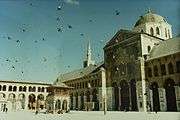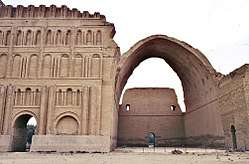Adina Mosque
| Adina Mosque আদিনা মসজিদ | |
|---|---|
|
Main façade of the Adina Mosque | |
| General information | |
| Construction started | 1373 |
| Completed | 1373 |
| Owner | Government of West Bengal |
The Adina Mosque (Bengali: আদিনা মসজিদ) is the ruins of the largest mosque in the Indian subcontinent, located in the Indian state of West Bengal near the border with Bangladesh. The site, dating from the 14th century, hosted the imperial mosque of the Sultanate of Bengal.[1]
Adina masjid
Design
The design of the mosque incorporated Bengali, Arab, Persian and Byzantine architecture. It was built with brick and stone. Its plan is similar to the Great Mosque of Damascus.[2] It had a rectangular hyspostyle structure with an open courtyard. There were several hundred domes. The structure measured 172 by 97 m. The entire western wall evokes the imperial style of pre-Islamic Sasanian Persia. The mosque's most prominent feature is its monumental ribbed barrel vault over the central nave, the first such huge vault built in the subcontinent, and another feature shared in common with the Sasanian style. The mosque consciously imitated Persianate imperial grandeur.[3] The prayer hall is five aisles deep, while the north, south and east cloisters around the courtyard consist of triple aisles. In total, these aisles had 260 pillars and 387 domed bays. The interior of the courtyard is a continuous façade of 92 arches surmounted by a parapet, beyond which the domes of the bays can be seen. The interior elevated platform, which was the gallery of the Sultan and his officials, still exists. The Sultan's tomb chamber is attached with the western wall.[4]
History



The mosque was built during the reign of Sikandar Shah, the second Sultan of the Ilyas Shahi dynasty of the Bengal Sultanate. The mosque was designed to display the kingdom's imperial ambitions after its two victories against the Delhi Sultanate in the 14th century.[5] The mosque may have been constructed on the ruins of Hindu-Buddhist temples and monasteries as its exterior wall contains defaced Indian sculptures. According to Encyclopedia Iranica, the mosque's construction material included stone from Bengali temples.[3]
Inscriptions on the mosque proclaimed Sikandar Shah as "the exalted Sultan" and the "Caliph of the faithful".[6] The Sultan was buried in a tomb chamber attached to the wall facing the direction of Mecca. The mosque was located in the now ruined city of Pandua, a former capital of the Bengal Sultanate.
It fell into ruin during the period of British rule and was damaged by earthquakes in the 19th century.
Jitu Santhal rebellion
On 3 December 1932 AD, Jitu Santhal, the leader of an anti-landlord movement in North Bengal had engaged in his last combat at the ruins of the Adina mosque. A largeband of Santhals, who had recently converted to Hinduism, marched up to the historic city of Pandua, occupied the ruins of Adina, and conducted a debased form of Hindu worship in order to transform the mosque into a temple.[7]
Jitu, who now called himself Gandhi, declared the end of British Raj and proclaimed his own government from within the mosque. Eventually, Jitu was killed in the vicinity of the mosque after a battle with armed police, who opened fire after the Santhals refused to come out.[8]
See also
References
| Wikimedia Commons has media related to Adina Mosque. |
- ↑ Eaton, Richard Maxwell (1 January 1996). "The Rise of Islam and the Bengal Frontier, 1204-1760". University of California Press – via Google Books.
- ↑ Hasan, Perween (15 August 2007). "Sultans and Mosques: The Early Muslim Architecture of Bangladesh". I.B.Tauris – via Google Books.
- 1 2 electricpulp.com. "BENGAL – Encyclopaedia Iranica".
- ↑ Banerji, Naseem Ahmed (1 January 2002). "The Architecture of the Adina Mosque in Pandua, India: Medieval Tradition and Innovation". Edwin Mellen Press – via Google Books.
- ↑ Eaton, Richard Maxwell (1996). The Rise of Islam in the Bengal Frontier, 1204-1760. University of California Press. p. 40-50. ISBN 0520205073.
- ↑ "Adina Mosque - Banglapedia".
- ↑ Sengupta, Saptarshi; Lochan, Pramila (October–December 2015). "Santhal Rebellion – A Counter Insurgency against 'Outsiders' As Ordained By a 'Thakur'". International Journal of Social Science and Humanities Research. 3 (4): 106-107. Retrieved 13 May 2018.
- ↑ Sengupta, Saptarshi; Lochan, Pramila (October–December 2015). "Santhal Rebellion – A Counter Insurgency against 'Outsiders' As Ordained By a 'Thakur'". International Journal of Social Science and Humanities Research. 3 (4): 107. Retrieved 13 May 2018.